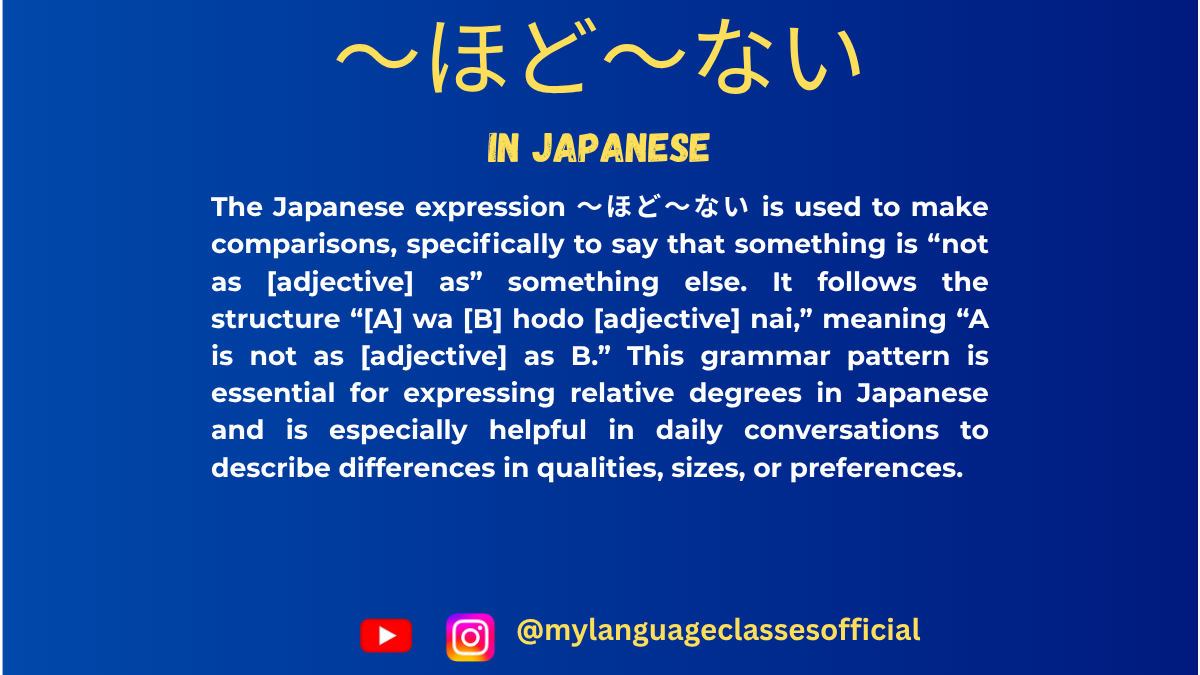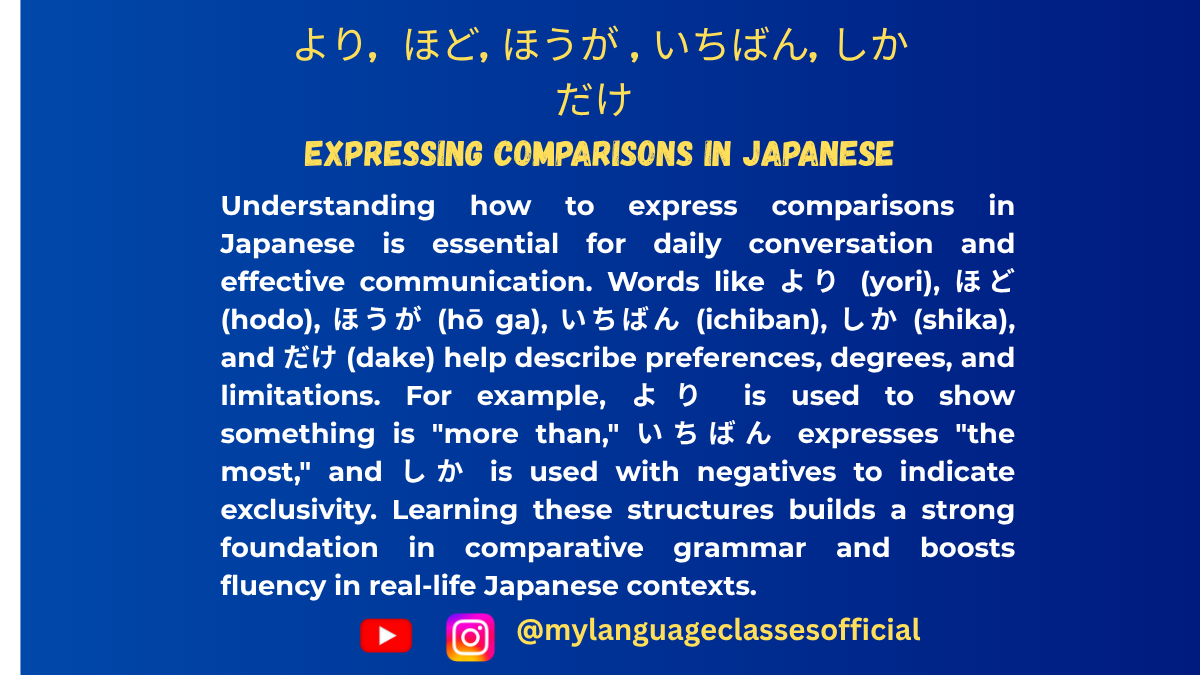Your cart is currently empty!
Tag: Japanese fluency
-

Using 〜ほど〜ない in Japanese | My Language Classes
Understanding 〜ほど〜ない in Japanese
The Japanese grammar pattern 「〜ほど〜ない」 is commonly used for making comparisons and expressing degree or extent. It implies that something is “not as much as” something else. This phrase is often translated as “not as… as…” in English.
Basic Structure of 〜ほど〜ない
The structure of this grammar pattern is as follows:
Noun + ほど + Adjective (ない-form)
or
Verb (dictionary form) + ほど + Adjective (ない-form)
General Meaning
「A ほど B ない」 means that B is not as A.
- A is the standard of comparison.
- B is the thing being compared.
Examples:
- この町は東京ほど賑やかではない。
(Kono machi wa Tōkyō hodo nigiyaka de wa nai.)
→ This town is not as lively as Tokyo. - 彼は私ほど速く走れない。
(Kare wa watashi hodo hayaku hashirenai.)
→ He cannot run as fast as I do. - この問題は思ったほど難しくない。
(Kono mondai wa omotta hodo muzukashiku nai.)
→ This problem is not as difficult as I thought.
Situations Where 〜ほど〜ない is Used
1. Comparing Extent or Degree
- Used when two things are compared, but the second one (B) has less intensity than the first (A).
Example:
北海道の冬は東京の冬ほど寒くない。
(Hokkaidō no fuyu wa Tōkyō no fuyu hodo samuku nai.)
→ Hokkaido’s winter is not as cold as Tokyo’s winter.2. Expressing Subjective Opinions
- Often used to express personal opinions about differences in perception.
Example:
数学は国語ほど難しくないと思います。
(Sūgaku wa kokugo hodo muzukashiku nai to omoimasu.)
→ I think math is not as difficult as Japanese.3. Negative Comparison in Abilities or Characteristics
- Used when comparing someone’s ability or characteristics with another’s.
Example:
彼の英語は先生ほど上手ではない。
(Kare no eigo wa sensei hodo jōzu de wa nai.)
→ His English is not as good as the teacher’s.4. Comparing Expectations vs Reality
- Used when expectations were high, but the actual situation is not as expected.
Example:
この映画は評判ほど面白くない。
(Kono eiga wa hyōban hodo omoshiroku nai.)
→ This movie is not as interesting as its reputation suggests.5. Comparing Feelings and Emotions
- Used when talking about feelings that are not as strong as expected.
Example:
彼は私が思ったほど優しくない。
(Kare wa watashi ga omotta hodo yasashiku nai.)
→ He is not as kind as I thought.6. Comparing Physical Condition or Health
- Used to compare health conditions or physical states.
Example:
風邪は思ったほどひどくない。
(Kaze wa omotta hodo hidoku nai.)
→ The cold is not as bad as I thought.7. Comparing Amount or Frequency
- Used when comparing quantity or frequency of actions.
Example:
今日は昨日ほど忙しくない。
(Kyō wa kinō hodo isogashiku nai.)
→ Today is not as busy as yesterday.8. Comparing Importance or Necessity
- Used when comparing levels of importance or necessity.
Example:
宿題はテストほど大事ではない。
(Shukudai wa tesuto hodo daiji de wa nai.)
→ Homework is not as important as tests.9. Comparing Strength of Desire or Preference
- Used to compare desires, preferences, or interests.
Example:
私は映画を見るのが好きですが、本を読むほど好きではない。
(Watashi wa eiga o miru no ga suki desu ga, hon o yomu hodo suki de wa nai.)
→ I like watching movies, but not as much as reading books.
Key Points to Remember About 〜ほど〜ない
- It is used for making comparisons where the second element has less intensity.
- It is often used to express subjective opinions.
- It is used to compare expectations vs reality.
- It can be used in various contexts: ability, frequency, amount, physical conditions, and emotions.
- It follows a simple pattern: “A ほど B ない”, where A is the standard, and B is the thing being compared.
Conclusion
The 「〜ほど〜ない」 grammar pattern is an essential part of Japanese when making negative comparisons. Mastering it will help you express your opinions, compare things effectively, and sound more natural in conversations. Make sure to practice using this structure in daily life to reinforce your understanding!
If you enjoyed this lesson, be sure to check out more posts like this on my blog at My Language Classes. Don’t forget to subscribe my YouTube channel and follow me on Instagram for the latest language learning tips and lessons. Leave a comment below to share your thoughts, or ask any questions you have about nouns.
Happy learning! 😊
-

Mastering Comparisons in Japanese より, ほど, ほうが, いちばん, しか, and だけ | My Language Classes
Expressing Comparisons in Japanese より, ほど, ほうが, いちばん, しか, and だけ
When learning Japanese, one of the most important concepts is mastering the art of comparisons. Whether you’re talking about how something is “better” or “more” than something else, or simply stating your preference, knowing how to compare effectively helps you express yourself clearly and confidently. In this post, we’ll cover some of the most essential comparison structures in Japanese: より (more than), ほど (more than / to the extent of), ほうが (preference), いちばん (the most), and dive into important distinctions such as より vs ほど and だけ vs しか.
1. より (More Than)
The particle より is used when comparing two items, indicating that one is more than the other. It’s the most straightforward way to show superiority or difference between two things.
Example:
- この映画はあの映画より面白いです。
Kono eiga wa ano eiga yori omoshiroi desu.
This movie is more interesting than that movie.
Here, より is used to compare the two movies, with the first one being more interesting than the second.
2. ほど (More Than / To the Extent of)
ほど is used to express a comparison where something is “more than” another thing, but with a focus on degree or extent. It’s often used when talking about how much more of something there is, especially in terms of actions or abilities.
Example:
- 彼は私ほど速く走れません。
Kare wa watashi hodo hayaku hashiremasen.
He can’t run as fast as I can.
Here, ほど is used to emphasize the difference in the degree of speed. It’s not just “more than” in quantity, but more in terms of ability or extent.
3. より vs ほど (Key Difference)
While both より and ほど can be translated as “more than,” the distinction lies in their nuance:
- より is used for simple comparisons, where one thing is greater or superior than another in a more straightforward sense.
- ほど is used when discussing the degree or extent of a comparison, often involving abilities, qualities, or actions. It can also suggest “to the extent that” or “as much as.”
Example:
- 彼は私より背が高いです。
Kare wa watashi yori se ga takai desu.
He is taller than I am.
(Simple comparison) - 彼は私ほど速く走れません。
Kare wa watashi hodo hayaku hashiremasen.
He can’t run as fast as I can.
(Degree of ability comparison)
4. ほうが (Preference)
The structure ほうが is used to express preference between two things, indicating that one thing is favored over the other.
Example:
- 日本の映画はアメリカの映画より面白いほうが好きです。
Nihon no eiga wa Amerika no eiga yori omoshiroi hō ga suki desu.
I prefer Japanese movies over American movies because they are more interesting.
In this sentence, ほうが emphasizes the preference for Japanese movies compared to American movies.
5. いちばん (The Most)
いちばん is used to indicate the highest degree of something, meaning “the most” or “the best.” It’s used when something stands out as the most in a particular category.
Example:
- 彼女はクラスでいちばんかわいいです。
Kanojo wa kurasu de ichiban kawaii desu.
She is the most beautiful in the class.
Here, いちばん is used to express that she is the top or number one in terms of beauty.
6. だけ (Only) vs しか (Only, but Negative)
Another pair worth noting in comparisons is だけ and しか. Both can be translated as “only,” but the way they are used is quite different.
- だけ is used to indicate a positive statement or simple limitation.Example:
- このレストランには寿司だけがあります。
Kono resutoran ni wa sushi dake ga arimasu.
This restaurant only has sushi.
- このレストランには寿司だけがあります。
- しか is used with a negative verb, indicating “only” but with the sense that there is nothing more than that (often implying something less than expected).Example:
- このレストランには寿司しかありません。
Kono resutoran ni wa sushi shika arimasen.
This restaurant only has sushi (and nothing else).
- このレストランには寿司しかありません。
Notice that with しか, a negative verb is required, while with だけ, the statement can be positive.
Tips for Mastering Comparisons
- Understand the Context: Pay attention to whether you’re making a straightforward comparison or discussing degrees of difference. This will help you choose between より and ほど.
- Practice with Real-Life Examples: Try comparing things you see around you. For example, compare two foods, two movies, or two places. This helps you internalize comparison structures.
- Use ほうが for Preferences: If you’re ever unsure about how to express a preference, use ほうが. It’s a simple way to show that you favor one thing over another.
- Avoid Overcomplicating Things: Don’t worry about using every comparison structure at once. Focus on mastering one at a time—start with より and いちばん, then gradually incorporate ほど and ほうが into your conversations.
- Listen to Native Speakers: Pay attention to how native speakers make comparisons. Listening to their natural flow will help you understand which structure to use in various situations.
Final Thoughts: Mastering Comparisons for Fluent Communication
Mastering comparisons in Japanese is a crucial step toward fluency. By understanding how to use より (more than), ほど (more than / to the extent of), ほうが (preference), and いちばん (the most), you’ll be able to express differences, preferences, and extremes with precision and confidence.
Remember that the key to becoming proficient in any aspect of a language is practice. The more you engage with these comparison structures in your speaking and writing, the more natural they will feel.
So, keep practicing, stay curious, and challenge yourself to use comparisons in your everyday conversations. With continued effort and attention to detail, you’ll be able to navigate the nuances of Japanese comparisons and speak like a native speaker in no time. Happy learning!
If you enjoyed this lesson, be sure to check out more posts like this on my blog at My Language Classes. Don’t forget to subscribe my YouTube channel and follow me on Instagram for the latest language learning tips and lessons. Leave a comment below to share your thoughts, or ask any questions you have about nouns.
Happy learning! 😊
- この映画はあの映画より面白いです。
